Midland Railway of Western Australia
(MRWA) Stations & Sidings
(MRWA) Stations & Sidings
Macpherson ●
Railway ●
Farms ●
War ●
Schools ●
Power ●
Roads ●
Business ●
Milk ●
Tearooms ●
Post ● Books ●
Toys







Below is a list of stations and sidings along the Midland Railway of
Western Australia (MRWA), kindly provided by Jeff Austin of Rail
Heritage WA in October 2014. For an
overview of the railway, please see our virtual
exhibition Midland Railway.
(WAGR = Western Australian Government Railways)
Midland Junction (0 miles 0 chains): Headquarters of the company’s rail operations, with administrative complex, workshops, engine and carriage sheds, goods shed, marshalling yard, loading bank, stockyards, coal stage, 25000 gallon overhead tank and 60ft turntable; all located between the WAGR stations at Midland Junction and West Midland. The property was bounded on the north side by Great Eastern Highway and to the east by Helena Street. On 18 January 1965 the WAGR closed the Midland Junction steam depot and moved to the former Midland Railway Co. depot. It became known as the Midland Motive Power diesel depot. When the new Forrestfield diesel depot opened in June 1969 the diesels were moved to the new facility and the Midland depot was used by contractors to scrap WAGR steam locomotives. The site was soon after sold and cleared for the Centrepoint Shopping Centre.
(1m 30 chains): the 1.5km long branch line from the passenger dock at the WAGR Midland Junction station joins. The points were permanently set for the branch line.
Janebrook [1st] (3 miles 3 chains): opened by 1897 and closed in 1913.
Middle Swan (3 miles 42 chains): opened in 1913 and named Janebrook [2nd]. Renamed Middle Swan on 27 June 1913. This siding served Whiteman’s brickworks and was removed on 13 December 1965.
(3 miles 65 chains): the dual gauge main lines merge with the MRWA formation. A temporary junction existed from 1964 until the opening of the Avon Valley route on 13 February 1966.
Oakover (4 miles 3 chains): opened by 1897 and closed on 31 March 1906.
Herne Hill (5 miles): opened on 3 September 1909. This siding had an Out-of-Shed and platform. Public siding removed 30 April 1945.
Millendon Junction (6 miles 60 chains) (0 km): junction of the Midland line and the dual gauge main lines.
(7 miles 10 chains) (0.6 km): the dual gauge main lines leave the MRWA reserve and turn east towards the Avon Valley.
Millendon (7 miles 75 chains) (2 km): opened 17 February 1922 with an Out-of-Shed and platform. Public siding removed 30 April 1945. Opened as a staff station on 22 February 1965 to facilitate movement of trains on the spur line into the Standard Gauge Material sidings. Train Order Crossing station introduced in August 1990.
(8 miles 60chains) (14 km): the railway crosses the large bridge over the Swan River. Originally there was a large timber trestle bridge here but this was replaced by the present concrete and steel structure by the WAGR.
Loton’s (9 miles 3 chains) (4 km): opened by 1897 and closed on 12 August 1904.
Upper Swan (9 miles 17 chains) (4 km): referred to in the construction days as ‘Swan River Siding’ and opened by 1894. This siding had an Out-of-Shed and platform. Opened as a staff station on 21 October 1964 and closed as a staff station on 22 February 1965. Eliminated on 1 January 1967.
Warbrook (13 miles 25 chains) (10 km): opened by 1897 as a passenger stopping place named Cranebrook. Closed in May 1897 but reopened on 10 April 1899, named Warbrook. Public siding removed 30 April 1945.
Bullsbrook (16 miles 65 chains) (16 km) : opened on 13 May 1897 with an Out-of-Shed and platform. Public siding removed on 1 February 1966 and stopping place closed on 12 August 1972.
Muchea (23 miles) (26 km): opened by 1894 as a Class 2 station, with a weatherboard and iron station building and passenger platform. There was a Station Master from 1 September 1910-1 January 1955 to manage the station and deal with train movements. A goods shed, loading bank, stockyards, 3-ton goods crane, and 15-ton Avery weighbridge were also provided over the years. The refreshment room from Gingin was relocated here and opened on 13 May 1932. A 4000 gallon overhead tank for watering locomotives was fed from a bore 200 metres east of the station. Opened as a staff station on 10 November 1964 and to a Train Order Crossing station from August 1990. The public siding was removed on 30 January 1978.
Chandala (26 miles 10 chains approx) (31 km): opened on 15 November 1989 as the siding for ‘Ti-West Joint Venture’ mineral sands plant. This siding closed in 2004 and the main line points have been removed.
Laidlaws (26 miles 60 chains) (32 km): opened 16 January 1914 as a private siding for James Laidlaw. The siding was removed in March 1917 but it remained open as a stopping place for passengers.
Chandalla [4th] (27 miles approx) (32 km): opened on 12 May 1911 and closed 1 September 1915.
Chandalla [1st & 3rd] (29 miles 71 chains) (37 km): opened by 1897. Also shown as Chandala. Was proposed to be a Class station but not built. Closed on 1 May 1901. Reopened on 22 March 1907 but finally closed on 12 May 1911.
Chandalla [2nd] (32 miles 20 chains) (41 km): opened on 1 May 1901. Also shown as Chandala. Closed on 22 March 1907.
Pettit (38 miles) (50 km): opened on 28 November 1919 and eliminated on 23 March 1923.
Gingin (39 miles 56 chains) (53 km): opened by the Governor, Sir William Robinson with the first section of the Midland Railway from Midland Junction on 9 April 1891. Soon after the opening in May 1891, the Managing Director, Mr H.W. Bond renamed the station Deane, in honour of the Governors wife, Lady Robinson. After protests from local residents, Lady Robinson graciously requested it revert to its former name. The name was also sometimes shown as Gin Gin. Was a Class 1 station, with an English-style brick station with quarters for the Station Master attached. A Station Master was appointed to this station from the opening in 1891 until the last was withdrawn on 30 April 1971. A goods shed, loading bank, stockyards, 3-ton goods crane, and 15-ton Avery weighbridge were also provided over the years. The refreshment room closed on 13 May 1932 and was relocated to Muchea. Water for steam locomotives was pumped from Gingin Brook to two tanks (4000 & 5000 gallons) at each end of the station yard. Gingin closed as a staff station on 30 March 1971 and the station closed on 23 May 1985. The station buildings are classified by the National Trust and placed on the Register of the National Estate.
Mooliabeenee (47 miles 60 chains) (66 km): opened by 1894. Was a Class 3 station with a weatherboard station building and passenger platform. This station probably had a Station Master pre 1920 but no names have been found nor dates of appointment. The original station buildings were destroyed by fire on 1 February 1911 and rebuilt. A goods shed, loading bank, stockyards and 15-ton Avery weighbridge were also provided over the years. Situated at the top of the steep Mooliabeenee Bank (1 in 52.5), a triangle for turning steam locomotives was located on the north side of the siding. The siding was renamed Mooliabeenie about 1965. The public siding was removed on 1 January 1971 and the siding opened as a staff station on 30 March 1971. Trial shipments of bauxite were loaded at this siding in recent years and it remains open (2014) as a Train Order Crossing station.
Cullalla (51 miles 22 chains) (71 km): opened by 1897 but closed on 5 November 1906. This siding reopened on 25 May 1917 with an Out-of-Shed and platform, and stockyards. Water for steam locomotives was pumped from a nearby soak to a 6000 gallon overhead tank. Cullalla was eliminated in January 1972.
Wannamal (60 miles 22 chains) (86 km): opened by 1897. This siding had an Out-of-Shed and platform, and sheds for the Per-Way gang. Eliminated on 22 March 1976.
Mogumber (68 miles 35 chains) (100 km): opened on 22 February 1892, named Moore River. Renamed Mogumber by 1894. The station house was weatherboard and iron, with quarters for the Station Master attached. A Station Master was appointed to this station from the opening in 1892 until the last was withdrawn on 1 December 1978. A passenger platform, Out-of-Shed, stockyards and 15-ton Avery weighbridge were also provided over the years. This station was a refreshment stop in the early days. Train Orders were introduced in 1990 and this siding is still open (2014) as a Train Order Crossing station and to serve the CBH grain storage bin.
(68 miles 75 chains) (101 km): the railway crosses the Moore River. The large timber MRWA bridge originally had a 12 metre truss in the middle but this was strengthened by a new central pier in 1910. The old bridge was replaced by the present concrete and steel structure in 1969.
(74 miles) (109 km): in the 1890’s an overhead tank existed for steam locomotives. Water was pumped from a well and creek.
Gillingarra (76 miles 10 chains) (112 km): opened by 1897. This siding had an Out-of-Shed and platform, and stockyards. Siding eliminated on 28 May 1990.
Koojan (85 miles 70 chains) (128 km): opened by 1897 and named Koogan up until 1946. This siding had an Out-of-Shed and platform, stockyards and sheds for the Per-Way gang. Water for locomotives was pumped from a dam to two overhead tanks (4000 & 8000 gallons) at each end of the siding. The water quality was very good and used by the WAGR for chromate water in the radiators of diesel locomotives. The siding was eliminated on 25 May 1986.
Barberton (91 miles 22 chains) (136 km): opened on 24 March 1899 named Elsternwick. Renamed Barberton on 1 November 1912. This siding had an Out-of-Shed and platform and stockyards. The siding was eliminated on 28 May 1990.
Moora Stockyards (96 miles) (144 km) : opened in October 1965. A short spur to the CBH grain storage bin was later built off this siding. Now known as Moora CBH.
Moora (97 miles 40 chains) (146 km): opened on 2 July 1894. Was a Class 3 station, with a weatherboard station house and passenger platform with quarters for the Station Master attached. A Station Master was appointed to this station from the opening in 1894 until the last was withdrawn on 31 August 1988. A refreshment room, goods shed, Out-of-Shed, loading bank, stockyards, 3-ton goods crane and 15-ton Avery weighbridge were also provided over the years. Water for locomotives was drawn from the town supply to two overhead tanks (4000 & 6000 gallons) at each end of the station yard. A new brick station on the west side of the line replaced the old timber building in September 1978. The semaphore signals were removed and the crossing loop converted to the main line on 19 February 1985. All remaining yard trackage was removed in November 1994. The ex MRWA diesel locomotive ‘F 41’ is displayed in a park.
Dalaroo (102 miles) (153 km): opened on 5 December 1913 as ‘102 Mile’ siding. Named Dalaroo on 9 January 1914 and provided with a loading bank. During World War 2, loading ramps were built at each end of the siding for unloading army tanks. Closed on 30 June 1945.
Cairn Hill [1st] (104 miles 10 chains) (157 km): opened during the 1920’s as a ballast siding. Closed as a staff station on 13 December 1965. Later reopened but closed on 8 June 1971.
Cairn Hill [2nd] (106 miles) (160 km): opened about 14 September 1989. Siding for loading quartz rock but has been closed since 2012.
Coomberdale (109 miles 46 chains) (166 km): opened in November 1894. This siding had an Out-of-Shed and platform, loading bank and stockyards. Still open (2014) to serve the CBH grain storage bin and as a Train Order Crossing station.
Namban (115 miles 48 chains) (176 km): opened on 6 January 1911. This siding had an Out-of-Shed and platform, loading bank and stockyards. A goods shed, ex Bayswater was erected on 20 August 1968. This siding closed as a Train Order Crossing station on 12 August 1993 and was eliminated on 31 January 1994.
Watheroo (121 miles 55 chains) (185 km): opened in November 1894. Was a Class 1 station, with a brick station house, refreshment room and passenger platform, with quarters for the Station Master attached. A Station Master was appointed to this station from the opening in 1894 until 30 June 1899 and again from 1 October 1911 until the last was withdrawn on 1 September 1981. A loading bank, stockyards and 3-ton goods crane were also provided over the years. Water for locomotives was provided from a dam 3km north-west of the station, to two 10,000 gallon overhead tanks in the station yard. A two road engine shed, carriage shed and 40ft turntable were originally provided, along with a coal stage and trainmen’s barracks. The engine shed was replaced in 1944 by a new concrete and brick building and this was converted into the goods shed on 27 May 1970. The triangle was removed on 21 February 1967. This station is still open (2014) to serve the CBH grain storage bin and as a Train Order Crossing station.
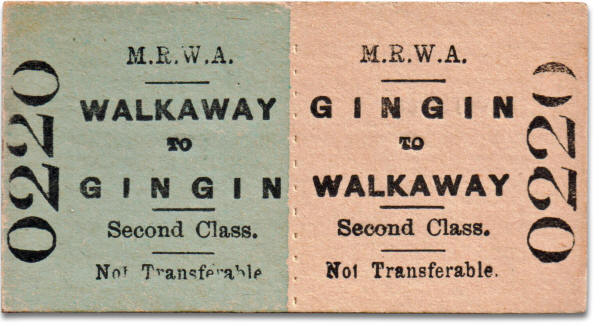
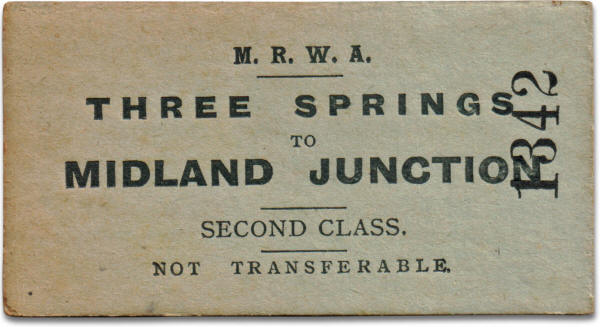
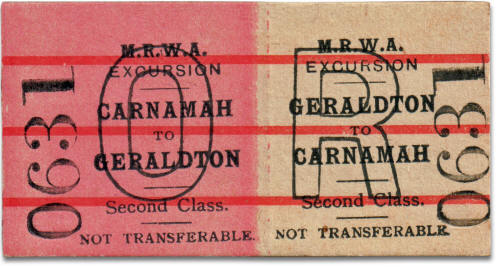
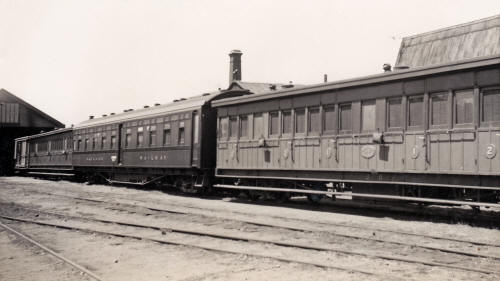
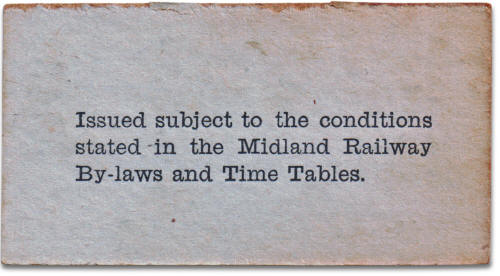
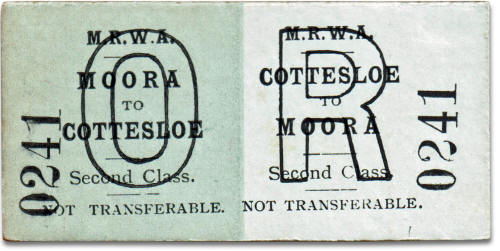
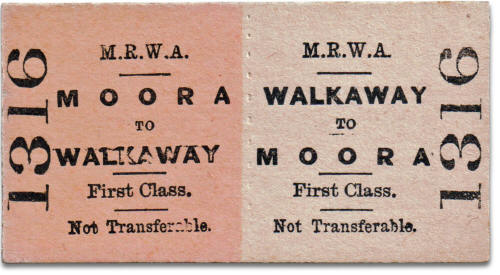
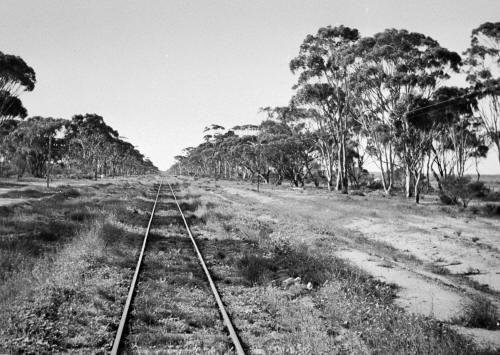
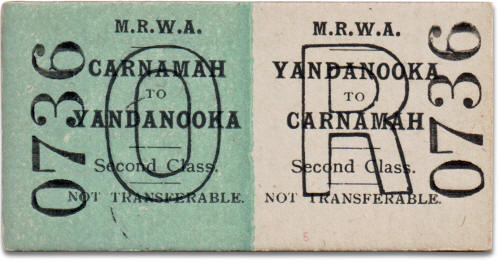
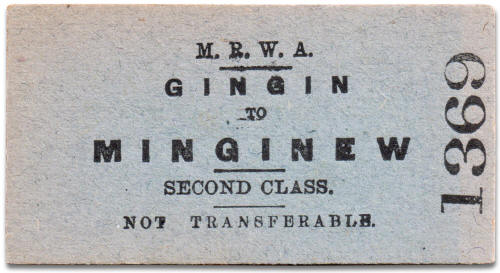
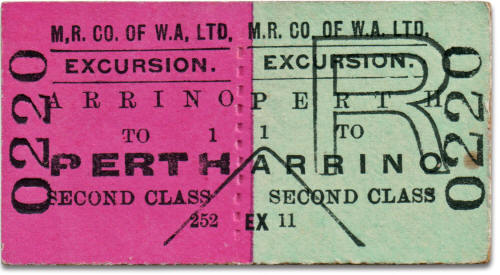
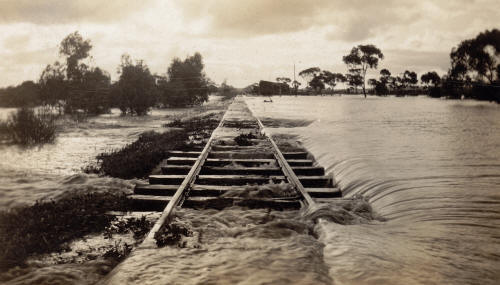
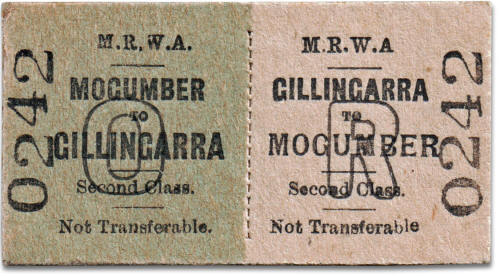
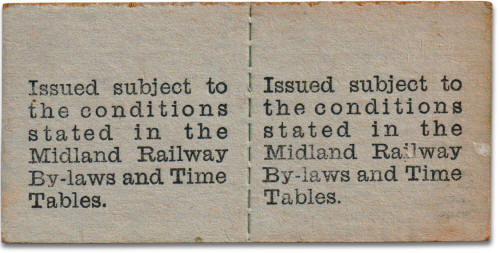
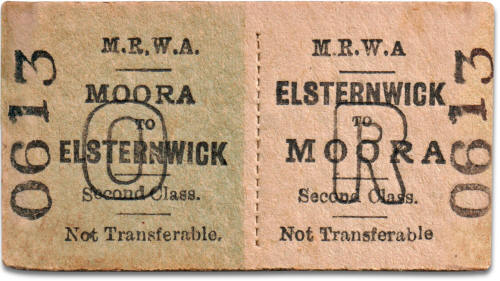
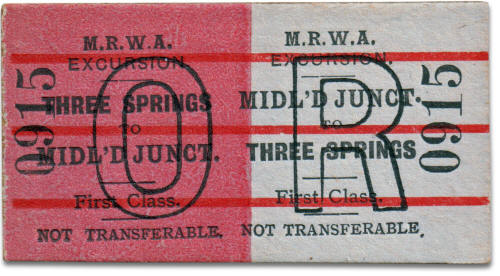
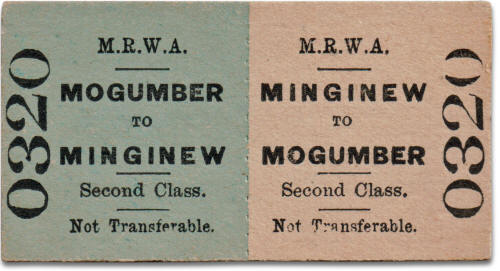
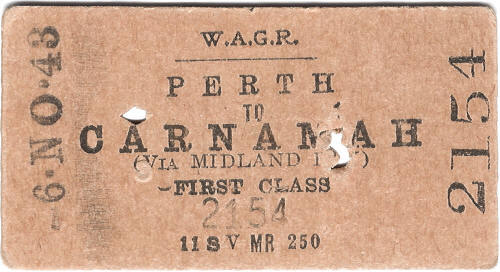
(WAGR = Western Australian Government Railways)
Midland Junction (0 miles 0 chains): Headquarters of the company’s rail operations, with administrative complex, workshops, engine and carriage sheds, goods shed, marshalling yard, loading bank, stockyards, coal stage, 25000 gallon overhead tank and 60ft turntable; all located between the WAGR stations at Midland Junction and West Midland. The property was bounded on the north side by Great Eastern Highway and to the east by Helena Street. On 18 January 1965 the WAGR closed the Midland Junction steam depot and moved to the former Midland Railway Co. depot. It became known as the Midland Motive Power diesel depot. When the new Forrestfield diesel depot opened in June 1969 the diesels were moved to the new facility and the Midland depot was used by contractors to scrap WAGR steam locomotives. The site was soon after sold and cleared for the Centrepoint Shopping Centre.
(1m 30 chains): the 1.5km long branch line from the passenger dock at the WAGR Midland Junction station joins. The points were permanently set for the branch line.
Janebrook [1st] (3 miles 3 chains): opened by 1897 and closed in 1913.
Middle Swan (3 miles 42 chains): opened in 1913 and named Janebrook [2nd]. Renamed Middle Swan on 27 June 1913. This siding served Whiteman’s brickworks and was removed on 13 December 1965.
(3 miles 65 chains): the dual gauge main lines merge with the MRWA formation. A temporary junction existed from 1964 until the opening of the Avon Valley route on 13 February 1966.
Oakover (4 miles 3 chains): opened by 1897 and closed on 31 March 1906.
Herne Hill (5 miles): opened on 3 September 1909. This siding had an Out-of-Shed and platform. Public siding removed 30 April 1945.
Millendon Junction (6 miles 60 chains) (0 km): junction of the Midland line and the dual gauge main lines.
(7 miles 10 chains) (0.6 km): the dual gauge main lines leave the MRWA reserve and turn east towards the Avon Valley.
Millendon (7 miles 75 chains) (2 km): opened 17 February 1922 with an Out-of-Shed and platform. Public siding removed 30 April 1945. Opened as a staff station on 22 February 1965 to facilitate movement of trains on the spur line into the Standard Gauge Material sidings. Train Order Crossing station introduced in August 1990.
(8 miles 60chains) (14 km): the railway crosses the large bridge over the Swan River. Originally there was a large timber trestle bridge here but this was replaced by the present concrete and steel structure by the WAGR.
Loton’s (9 miles 3 chains) (4 km): opened by 1897 and closed on 12 August 1904.
Upper Swan (9 miles 17 chains) (4 km): referred to in the construction days as ‘Swan River Siding’ and opened by 1894. This siding had an Out-of-Shed and platform. Opened as a staff station on 21 October 1964 and closed as a staff station on 22 February 1965. Eliminated on 1 January 1967.
Warbrook (13 miles 25 chains) (10 km): opened by 1897 as a passenger stopping place named Cranebrook. Closed in May 1897 but reopened on 10 April 1899, named Warbrook. Public siding removed 30 April 1945.
Bullsbrook (16 miles 65 chains) (16 km) : opened on 13 May 1897 with an Out-of-Shed and platform. Public siding removed on 1 February 1966 and stopping place closed on 12 August 1972.
Muchea (23 miles) (26 km): opened by 1894 as a Class 2 station, with a weatherboard and iron station building and passenger platform. There was a Station Master from 1 September 1910-1 January 1955 to manage the station and deal with train movements. A goods shed, loading bank, stockyards, 3-ton goods crane, and 15-ton Avery weighbridge were also provided over the years. The refreshment room from Gingin was relocated here and opened on 13 May 1932. A 4000 gallon overhead tank for watering locomotives was fed from a bore 200 metres east of the station. Opened as a staff station on 10 November 1964 and to a Train Order Crossing station from August 1990. The public siding was removed on 30 January 1978.
Chandala (26 miles 10 chains approx) (31 km): opened on 15 November 1989 as the siding for ‘Ti-West Joint Venture’ mineral sands plant. This siding closed in 2004 and the main line points have been removed.
Laidlaws (26 miles 60 chains) (32 km): opened 16 January 1914 as a private siding for James Laidlaw. The siding was removed in March 1917 but it remained open as a stopping place for passengers.
Chandalla [4th] (27 miles approx) (32 km): opened on 12 May 1911 and closed 1 September 1915.
Chandalla [1st & 3rd] (29 miles 71 chains) (37 km): opened by 1897. Also shown as Chandala. Was proposed to be a Class station but not built. Closed on 1 May 1901. Reopened on 22 March 1907 but finally closed on 12 May 1911.
Chandalla [2nd] (32 miles 20 chains) (41 km): opened on 1 May 1901. Also shown as Chandala. Closed on 22 March 1907.
Pettit (38 miles) (50 km): opened on 28 November 1919 and eliminated on 23 March 1923.
Gingin (39 miles 56 chains) (53 km): opened by the Governor, Sir William Robinson with the first section of the Midland Railway from Midland Junction on 9 April 1891. Soon after the opening in May 1891, the Managing Director, Mr H.W. Bond renamed the station Deane, in honour of the Governors wife, Lady Robinson. After protests from local residents, Lady Robinson graciously requested it revert to its former name. The name was also sometimes shown as Gin Gin. Was a Class 1 station, with an English-style brick station with quarters for the Station Master attached. A Station Master was appointed to this station from the opening in 1891 until the last was withdrawn on 30 April 1971. A goods shed, loading bank, stockyards, 3-ton goods crane, and 15-ton Avery weighbridge were also provided over the years. The refreshment room closed on 13 May 1932 and was relocated to Muchea. Water for steam locomotives was pumped from Gingin Brook to two tanks (4000 & 5000 gallons) at each end of the station yard. Gingin closed as a staff station on 30 March 1971 and the station closed on 23 May 1985. The station buildings are classified by the National Trust and placed on the Register of the National Estate.
Mooliabeenee (47 miles 60 chains) (66 km): opened by 1894. Was a Class 3 station with a weatherboard station building and passenger platform. This station probably had a Station Master pre 1920 but no names have been found nor dates of appointment. The original station buildings were destroyed by fire on 1 February 1911 and rebuilt. A goods shed, loading bank, stockyards and 15-ton Avery weighbridge were also provided over the years. Situated at the top of the steep Mooliabeenee Bank (1 in 52.5), a triangle for turning steam locomotives was located on the north side of the siding. The siding was renamed Mooliabeenie about 1965. The public siding was removed on 1 January 1971 and the siding opened as a staff station on 30 March 1971. Trial shipments of bauxite were loaded at this siding in recent years and it remains open (2014) as a Train Order Crossing station.
Cullalla (51 miles 22 chains) (71 km): opened by 1897 but closed on 5 November 1906. This siding reopened on 25 May 1917 with an Out-of-Shed and platform, and stockyards. Water for steam locomotives was pumped from a nearby soak to a 6000 gallon overhead tank. Cullalla was eliminated in January 1972.
Wannamal (60 miles 22 chains) (86 km): opened by 1897. This siding had an Out-of-Shed and platform, and sheds for the Per-Way gang. Eliminated on 22 March 1976.
Mogumber (68 miles 35 chains) (100 km): opened on 22 February 1892, named Moore River. Renamed Mogumber by 1894. The station house was weatherboard and iron, with quarters for the Station Master attached. A Station Master was appointed to this station from the opening in 1892 until the last was withdrawn on 1 December 1978. A passenger platform, Out-of-Shed, stockyards and 15-ton Avery weighbridge were also provided over the years. This station was a refreshment stop in the early days. Train Orders were introduced in 1990 and this siding is still open (2014) as a Train Order Crossing station and to serve the CBH grain storage bin.
(68 miles 75 chains) (101 km): the railway crosses the Moore River. The large timber MRWA bridge originally had a 12 metre truss in the middle but this was strengthened by a new central pier in 1910. The old bridge was replaced by the present concrete and steel structure in 1969.
(74 miles) (109 km): in the 1890’s an overhead tank existed for steam locomotives. Water was pumped from a well and creek.
Gillingarra (76 miles 10 chains) (112 km): opened by 1897. This siding had an Out-of-Shed and platform, and stockyards. Siding eliminated on 28 May 1990.
Koojan (85 miles 70 chains) (128 km): opened by 1897 and named Koogan up until 1946. This siding had an Out-of-Shed and platform, stockyards and sheds for the Per-Way gang. Water for locomotives was pumped from a dam to two overhead tanks (4000 & 8000 gallons) at each end of the siding. The water quality was very good and used by the WAGR for chromate water in the radiators of diesel locomotives. The siding was eliminated on 25 May 1986.
Barberton (91 miles 22 chains) (136 km): opened on 24 March 1899 named Elsternwick. Renamed Barberton on 1 November 1912. This siding had an Out-of-Shed and platform and stockyards. The siding was eliminated on 28 May 1990.
Moora Stockyards (96 miles) (144 km) : opened in October 1965. A short spur to the CBH grain storage bin was later built off this siding. Now known as Moora CBH.
Moora (97 miles 40 chains) (146 km): opened on 2 July 1894. Was a Class 3 station, with a weatherboard station house and passenger platform with quarters for the Station Master attached. A Station Master was appointed to this station from the opening in 1894 until the last was withdrawn on 31 August 1988. A refreshment room, goods shed, Out-of-Shed, loading bank, stockyards, 3-ton goods crane and 15-ton Avery weighbridge were also provided over the years. Water for locomotives was drawn from the town supply to two overhead tanks (4000 & 6000 gallons) at each end of the station yard. A new brick station on the west side of the line replaced the old timber building in September 1978. The semaphore signals were removed and the crossing loop converted to the main line on 19 February 1985. All remaining yard trackage was removed in November 1994. The ex MRWA diesel locomotive ‘F 41’ is displayed in a park.
Dalaroo (102 miles) (153 km): opened on 5 December 1913 as ‘102 Mile’ siding. Named Dalaroo on 9 January 1914 and provided with a loading bank. During World War 2, loading ramps were built at each end of the siding for unloading army tanks. Closed on 30 June 1945.
Cairn Hill [1st] (104 miles 10 chains) (157 km): opened during the 1920’s as a ballast siding. Closed as a staff station on 13 December 1965. Later reopened but closed on 8 June 1971.
Cairn Hill [2nd] (106 miles) (160 km): opened about 14 September 1989. Siding for loading quartz rock but has been closed since 2012.
Coomberdale (109 miles 46 chains) (166 km): opened in November 1894. This siding had an Out-of-Shed and platform, loading bank and stockyards. Still open (2014) to serve the CBH grain storage bin and as a Train Order Crossing station.
Namban (115 miles 48 chains) (176 km): opened on 6 January 1911. This siding had an Out-of-Shed and platform, loading bank and stockyards. A goods shed, ex Bayswater was erected on 20 August 1968. This siding closed as a Train Order Crossing station on 12 August 1993 and was eliminated on 31 January 1994.
Watheroo (121 miles 55 chains) (185 km): opened in November 1894. Was a Class 1 station, with a brick station house, refreshment room and passenger platform, with quarters for the Station Master attached. A Station Master was appointed to this station from the opening in 1894 until 30 June 1899 and again from 1 October 1911 until the last was withdrawn on 1 September 1981. A loading bank, stockyards and 3-ton goods crane were also provided over the years. Water for locomotives was provided from a dam 3km north-west of the station, to two 10,000 gallon overhead tanks in the station yard. A two road engine shed, carriage shed and 40ft turntable were originally provided, along with a coal stage and trainmen’s barracks. The engine shed was replaced in 1944 by a new concrete and brick building and this was converted into the goods shed on 27 May 1970. The triangle was removed on 21 February 1967. This station is still open (2014) to serve the CBH grain storage bin and as a Train Order Crossing station.
































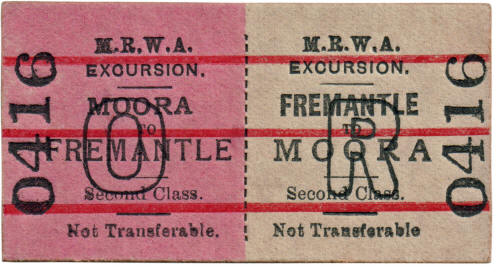

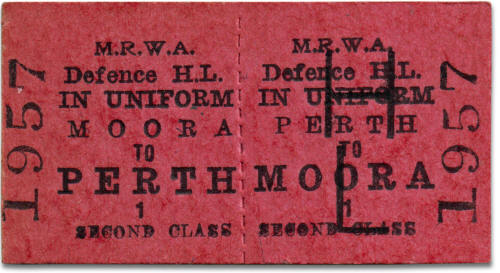


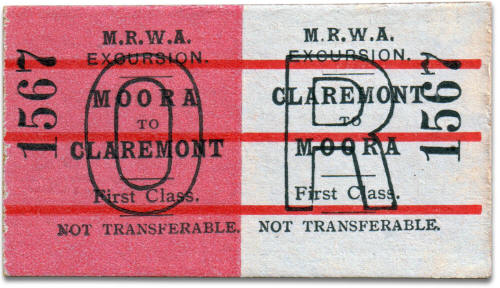
Gunyidi (132 miles 30 chains) (203 km): opened on 5 February 1909 as ‘132 Mile’ siding. Named Gunyidi on 12 February 1909. This siding was provided with an Out-of-Shed and platform. On 24 July 1917, the Mail train derailed on a washaway, 3km north of this siding. Three people died and 13 others were injured. The siding closed as a staff station on 6 December 1965 and was eliminated on 31 January 1994.
Coorow (152 miles 2 chains) (234 km): opened in November 1894. Was a Class 3 station, with a weatherboard station house and passenger platform. A Station Master was appointed to this station from 1 December 1913, until the last was withdrawn on 28 June 1985. An Out-of-Shed, loading bank and stockyards were also provided over the years. Water for locomotives was pumped from two dams south of the station, to two overhead tanks (6000 & 8000 gallons) at each end of the station yard. A new trainmen’s barracks was opened on 13 November 1989. This station is still open (2014) to serve the CBH grain storage bin and as a Train Order Crossing station. The later transportable station building still exists in 2014.
Touche (157 miles) (242 km): this siding opened on 6 June 1930 and was named after one of the Midland Railway Company directors, Sir George Touche. Locomotive water was drawn from a salt water well and pumped to an overhead tank alongside the main line. A triangle was also constructed off the siding for turning steam locomotives. Touche was eliminated in November 1958.
Winchester (162 miles 35 chains) (251 km): opened on 30 April 1909 as ‘162 Mile’ siding and named Winchester on 1 November 1912. This siding was provided with an Out-of-Shed and platform, and stockyards. The siding was eliminated on 23 May 1985.
Carnamah (168 miles 70 chains) (261 km): opened in November 1894. Was a Class 3 station, with a weatherboard station house and passenger platform. A Station Master was appointed to this station from 1 June 1897-28 February 1899, 1 October 1907-1 December 1913 and 1 February 1921, until the last was withdrawn on 19 October 1984. A goods shed, loading bank, stockyards and 3-ton goods crane were also provided over the years. A transportable station building was used in later years until it was also removed. The crossing loop is the loading point for CBH and is located at the north end of the former yard. Carnamah is still open (2014) to serve the CBH grain storage bin and as a Train Order Crossing station.
Prowaka (174 miles 40 chains) (270 km): opened on 13 December 1915 named Yarri. Renamed Prowaka on 30 June 1916. This siding was eliminated on 1 January 1971.
(179m 28 chains) (278km): on 1 November 1894 the two construction gangs working from the north and south, met at this location.
(180 miles 30 chains) (279 km): the railway crosses the Yarra Yarra Lakes on a lengthy culvert. The original 1894 bridge was on the present day alignment. The second bridge, made of 40 x 5 metre timber spans still stands alongside the new formation.
Three Springs (183 miles 10 chains) (284 km): opened in November 1894. Was a Class 3 station, with a non standard weatherboard station house and passenger platform. A Station Master was appointed to this station from November 1894- ? and 1 July 1910, until the last was withdrawn on 28 February 1992. Three Springs was the only station on the Midland Railway to be built on the ‘main’ instead of the ‘loop’. A goods shed, loading bank, stockyards, 5-ton goods crane and cart weighbridge were also provided over the years. A modern brick station was built in the 1960’s to replace the old timber building. The semaphore signals at each end of the yard were removed on 30 December 1987. Train Orders were introduced from Three Springs-Narngulu in June 1988, and Three Springs-Millendon in August 1990. A long siding was located south of the main yard and accommodated a loading ramp to transfer bulk talc into hopper wagons. The loading ramp was removed in 2014. This station is still open (2014) to serve the CBH grain silo and as a Train Order Crossing station.
Lynch (191 miles 20 chains) (297 km): opened on 27 November 1911 as ‘192 Mile’ siding. A loading bank was provided and a spur line, 1.3km long, ran to a ballast pit. Named Womar on 11 February 1916 and renamed Lynch in June 1924. Siding closed on 29 December 1936.
Pitfield (191 miles 73 chains) (298 km): opened on 29 December 1936 with loading bank and livestock races. Closed on 24 December 1966 and removed in 1967. Reopened as a temporary ballast siding on 3 June 1983 and removed on 13 February 1985.
Arrino (194 miles 20 chains) (302 km): opened in February 1892. Was a Class 3 station, with a weatherboard station house and passenger platform. A Station Master was appointed to this station from 1 April 1911, until the last was withdrawn on 1 November 1966. A goods shed, loading bank, stockyards, goods crane and 15-ton Avery weighbridge were also provided over the years. Water for locomotives was raised by windmills from bores south of the station, to two overhead tanks (4000 & 6000 gallons) at each end of the station yard. Arrino opened as a staff station on 20 January 1976 and closed as a staff station on 17 January 1983. This station is still open (2014) to serve the CBH grain storage bin and as a Train Order Crossing station.
Yandanooka (204 miles 35 chains) (309 km): opened by 1894. This siding was provided with an Out-of-Shed and platform, and stockyards. Yandanooka opened as a Train Order Non Crossing station on 8 February 1993 but the public siding was eliminated from 31 January 1994.
Mingenew (216 miles 50 chains) (338 km): opened by the Commissioner of Railways, Mr. H.W. Venn and Engineer-in-Chief, Mr C. Y. O’Connor on 16 August 1891. The name is sometimes shown as Minginew prior to 1904. Was a Class 1 station, with an impressive stone station, passenger platform, refreshment room and quarters for the Station Master attached. A Station Master was appointed to this station from the opening in 1891 until the last was withdrawn on 28 June 1985. This station was also a loco depot and crew changeover point. A goods shed, loading bank, stockyards, 3-ton goods crane, coal stage, triangle and trainmen’s barracks were also provided over the years. Water for locomotives was provided from “Erragulla Springs” and piped to two overhead tanks (4000 & 6500 gallons) in the station yard. Of the original station building, the Station Masters office and residence were demolished in 1974 but the 1947 refreshment room and waiting rooms still remain. The semaphore signals were removed on 17 April 1984. CBH/ Watco laid an additional siding during 2012 on the southern end of the former yard to service their locomotives and wagons. This station is still open (2014) to serve the CBH grain storage bin and as a Train Order Crossing station.
Lockier (222 miles 24 chains) (348 km): opened by February 1892 named Oliver’s. Renamed Lockier by 1895. Public siding closed on 30 June 1945 and eliminated as a stopping place in September 1956.
(228 miles 26 chains) (358 km): the railway crosses the Irwin River. The original iron bridge was built by ‘The Horsehay Co’, Shropshire, England in 1891. It was replaced in the 1980s by a concrete and steel structure.
Strawberry [1st] (229 miles 25 chains) (359 km): opened in August 1891. Early drawings show the siding named Strawberry Hill. This siding was provided with an Out-of-Shed and platform, and stockyards. The siding was eliminated on 2 February 1981.
Strawberry [2nd] (232 miles 60 chains) (365 km): opened as a Train Order Non Crossing station in June 1988.
(237 miles 52 chains) (372 km): an overhead tank provided locomotive water from a windmill and well. A pipe from this well also ran alongside the railway to the tank at Irwin siding.
Irwin (240 miles 20 chains) (376 km): opened in August 1891. This siding was provided with an Out-of-Shed and platform, and stockyards. Water for locomotives was piped from the well at ‘237m 52c’ and from a soak, 1km south, to a 4000 gallon overhead tank at the siding. Opened as a staff station in August 1974 and closed as a staff station on 17 January 1983. The public siding was eliminated on 25 May 1986. The stockyards still exist at this location but no longer used. Irwin is still open (2014) as a Train Order Non Crossing station.
Yardarino (242 miles 58 chains) (380 km): opened in August 1891 named Yarradino. Renamed Yardarino by 1907. This siding was provided with an Out-of-Shed and platform, and stockyards. Eliminated on 3 March 1969.
Dongara Bypass (250 miles 25 chains) (393 km): opened on 1 June 1975, to allow for the new railway to Eneabba (opened 20 April 1976). The new alignment is 0.9km shorter than the old route and rejoins the original formation at 253m 0c.
Dongara East (251 miles): opened by February 1892 and closed by 1897.
Dongara [1st] (252 miles 35 chains): opened by the Commissioner of Railways, Mr H. W. Venn on 17 April 1891 [the station building was opened in 1892]. Renamed Dongarra about 1908 but changed to Dongara in 1946. Was a Class 1 station, with a stone station house, refreshment room and passenger platform. A Station Master was appointed to this station from the opening in 1891 until the last was relocated to the new station on 1 June 1975. A goods shed, loading bank, stockyards, goods crane and 15-ton Avery weighbridge were also provided over the years. Closed by the opening of the new bypass on 1 June 1975 and all buildings demolished.
Dongara [2nd] (394 km): opened on the new bypass on 1 June 1975. A transportable station building was provided for the Station Master until the last was withdrawn on 19 October 1984. Dongara is still open (2014) as a Train Order Crossing station but train services have not run on the Eneabba railway since February 2013.
Bookara (267 miles 3 chains) (419 km): opened in April 1891 named King’s Siding. Renamed Bokara by 1895 and to Bookara about 1915. This siding was provided with an Out-of-Shed and platform, and stockyards. The public siding was closed on 22 September 1975. Opened as a staff station on 12 June 1976 and closed as a staff station on 17 January 1983. Reopened as a Train Order Non Crossing station on 25 March 1991.
Crampton (274 miles 45 chains) (431 km): opened in April 1891 named Greenough Road. Renamed Crampton on 5 April 1915. Closed and removed 30 June 1945.
(275 miles 60 chains) (433 km): the railway crosses the Greenough River bridge
Walkaway [Loco Depot] (276 miles 10 chains) (434 km): opened by 1891. Locomotive depot and trainmen’s barracks for MRWA trains. Had a locomotive shed, carriage shed, coal stage, overhead tank and 40ft turntable (later replaced by a triangle). A double track ran from this yard into Walkaway station. This depot closed after the government takeover in 1964 and it was converted into a ballast siding, known as Walkaway Ballast Siding. Renamed Walkaway in October 1988. An additional loop was constructed during 2013 to accommodate the loading of ballast trains to keep the crossing loop clear.
Walkaway (276 miles 74 chains) (435 km): opened on 1 July 1887 and was always a WAGR station. The MRWA trackage finished on the south side of the Evans Road level crossing. A Station Master was appointed to this station from the opening in 1887 until the last was withdrawn in September 1965. The salaries of the station staff were shared between the government and MRWA. The impressive English-style stone station is a twin of Claremont station and was built in 1888. This building, goods shed and loading bank are classified by the National Trust. The only surviving MRWA steam locomotive ‘B 6’ is preserved in the goods shed. A turntable was provided for turning WAGR locomotives. Closed as a staff station on 17 January 1983. The public siding closed on 25 May 1986.
For an overview of the railway and one of its land schemes, see our virtual exhibitions:
● Midland Railway of Western Australia
● Ready-Made Farms
V i r t u a l M u s e u m :
Macpherson ● Railway ● Farms ● War ● Schools ● Power ● Roads ● Business ● Milk ● Tearooms ● Post ● Books ● Toys
Now featuring 10863 Bushranger presented by Act Belong Commit







